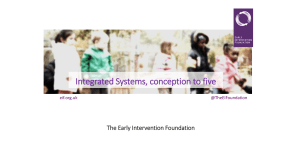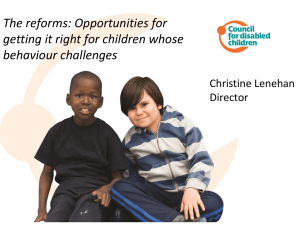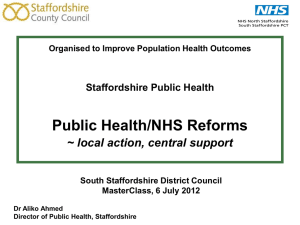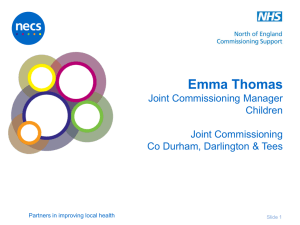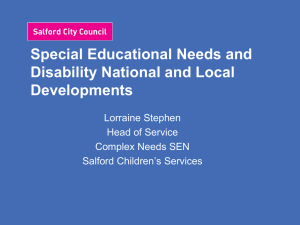Achieving Excellence in Learning and Skills: Implementing the 0
advertisement
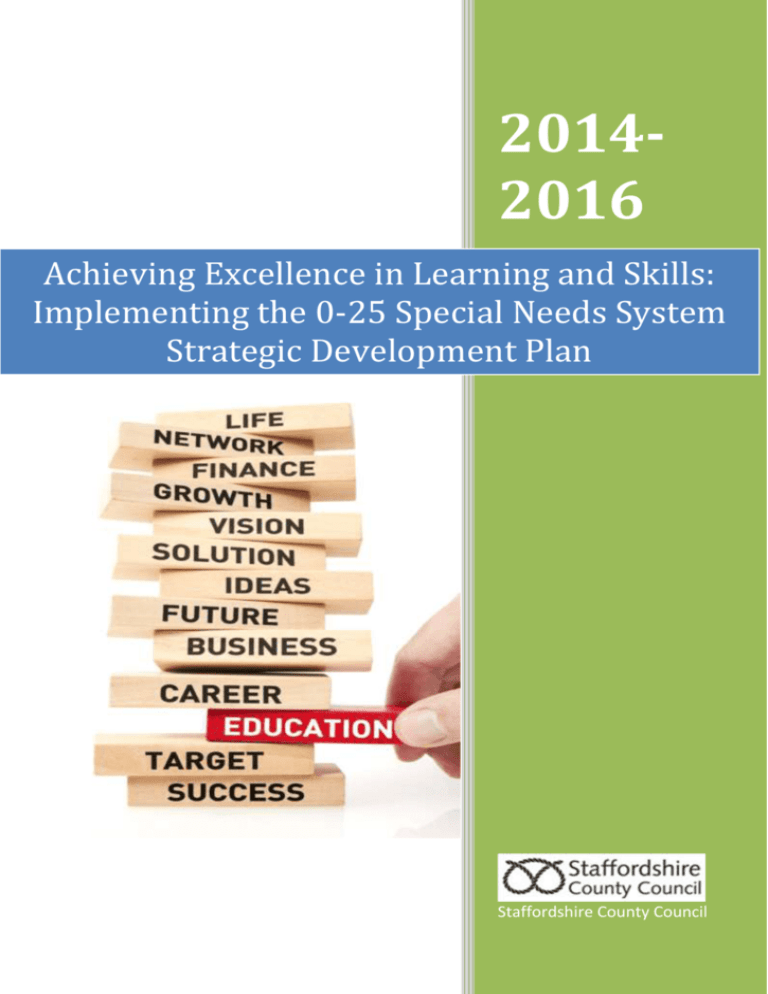
20142016 Achieving Excellence in Learning and Skills: Implementing the 0-25 Special Needs System Strategic Development Plan Staffordshire County Council Achieving Excellence in Learning and Skills: Implementing the 0-25 Special Needs System Strategic Development Plan 2014-2016 Introduction: Our Vision for Special Educational Need and Disability in Staffordshire Staffordshire County Council has a clear vision that we want to make real for the whole county – a Connected Staffordshire, where everyone has the opportunity to prosper, be healthy and happy. In our strategy Achieving Excellence in Learning and Skills 2014-2016 we have set out our strategic approach to ensure that every child or young person in our area gets the good standard of education that is essential as a foundation to living a healthy, happy and prosperous life. Our strategy embraces all children and young people and sets clear expectations that each part of the system, including parents and children and young people themselves, plays an active and essential part if we are to achieve the full potential of unlocking talent and ability. There is an incrementally increasing expectation of mainstream schools, colleges and training providers. The national funding reforms place a far greater proportion of the resources available directly into the hands of schools. Schools have greater freedom and control over how to allocate and utilise these resources in order to get the very best value for money, squeezing maximum value from the public investment, and targeting the use of funds to the places they will make the biggest difference. Therefore, pivotal to the new arrangements for Special Educational Needs and Disability (SEND) is a clear and unequivocal presumption that mainstream schools, colleges and other settings do more to meet the additional needs of the vast majority of learners. In addition to the mainstream costs of educating any pupil or student, funding for up to the first six thousand pounds of additional support for a learner is embedded within the mainstream budget. For all but a very small proportion of our total number of learners, their educational needs are met through core resources that need to be flexed and targeted to meet their particular needs, however wide-ranging these may be. Our schools and setting s have considerable expertise to do this, and most importantly they have the first- hand knowledge and face to face contact with both the child and the family so are best positioned to recognise and respond to particular needs. To illustrate this, Staffordshire’s School Census 2013 revealed that of the 124,248 pupils attending a Staffordshire Schools 20,847 or 16.8% had a special educational need identified. Of these, 3,615 had needs that led to a Statement of Special Educational Need or 2.9% of pupils. Therefore, all but 3% of children and young people have their needs identified and met in full through the resources and expertise existing within their school or setting, supported as appropriate through the range of services that deliver Early Help. Staffordshire is in line with similar authorities in the proportion of pupils with SEN Statements, featuring midway in comparison tables with our statistical neighbours. It has long been recognised both nationally and locally that for the small proportion of learners with the most complex needs the current system is complex, bureaucratic and ultimately has not always allowed them to achieve to their full potential. The Children and Families Act 2014 is the 1 culmination of years of working for a better system and it sets out major reforms to the SEND system. These will take effect starting from September 2014. The reforms are long awaited and very much welcomed both locally and nationally. There are core principles to the reform - placing children, young people and their families at the heart of the approach, with choice and control – that align with our local ambitions. Implementing these reforms will help to ensure that learners with the most complex needs are better supported to achieve to their full potential to lead the lives they aspire to. In Living My Life, My Way Staffordshire County Council’s Strategy for Disabled People 2013-2018 we set out our aspiration that: “All children and young people with SEN and Disability receive the right support, at the right time, and in the right way, so that they are able to realise their potential and lead fulfilling lives.” In this Strategic Development Plan for SEND 2014-2016 we set out how we will implement the SEND reforms in a way that delivers our aspiration, delivering a truly local approach that works within the legislative framework and reform timetable. Why are the SEND reforms so important to us? A good education is one of the best investments we can ever make in life. In terms of laying down the foundations for a happy, healthy and prosperous future there is little that beats it. Ask any parent and they will tell you how important it is to them that they have access to the best schools and a good education for their children. Ask any business and they will tell you how important the skills of their workforce are in both improving productivity and driving innovation. All of our children and young people deserve an equal chance to get a good education. In the SEND Green Paper 2011 the government made it clear that there was a very strong case for change as “we are letting children and young people down.” They described the existing national approach as “a system where parents feel they have to battle for the support they need, where they are passed from pillar to post, and where bureaucracy and frustration face them at every step”. The system had sat unreformed for almost 30 years so the radical reform of the Children and Families Act 2014 has been welcomed. It states: “We want children and young people with special educational needs and disabilities to achieve well in their early years, at school and in college; find employment; lead happy and fulfilled lives; and have choice and control over their support.” These reforms provide a unique and powerful opportunity to reshape the local system so that it operates better and in the interests of local people. Staffordshire County Council has worked in close collaboration with Parent Carer Forums and the Parent Partnership Service to engage and consult extensively with local people on the implementation of these reforms. We have heard their stories, understood their needs and redesigned our local approach to better deliver to their aspirations and ambitions. Appendix 1 gives a fuller summary of the feedback from parents, but in essence, they want: 2 Information and support at the right time and place and in the right format To be involved in decision-making for their child To help shape the design of the services To give their information only once Their child to be safe and happy Transition to adulthood to be successful What are the Benefits of Success and the Costs of Failure? There are very many stories of success and a strong network of local provision that is dedicated to providing the very best education for learners with SEND. Staffordshire has a strong and sustained record of success in its special schools with 13 judges as good (56.5%) and 9 judged as outstanding (39.1%) and innovative and ground-breaking local approaches. One exciting example is that we are just completing the pilot phase (June 2014) of a ‘wrap-around’ provision for children in Key Stages 1 and 2, which gives the young person intensive support from the autism outreach team within the school. Intensive support is available for up to 34 individuals with complex ASD and challenging behaviour, as this was identified by the primary schools as being a key issue. Initial evaluations suggest this has had positive impact on the children, families and schools involved. Another forward looking development is where four special schools have come together with their experience and knowledge to create a standalone company to deliver a bespoke service for physically disabled young people. However, both nationally and locally Children and young people with SEND do less well than their peers at school and college. They are more likely to be out of education, training or employment – categorised as NEET. Employment opportunities for people with SEND are limited and the costs of this both at personal and public level are not acceptable. For example, the cost to the public purse of supporting a person with a moderate learning disability through adult life (age 16-64) is £2-3 million based on National Audit Office estimates. Nationally adult care costs for those with a learning difficult or disability are second only to the costs of supporting the elderly (£5.19 billion compared to £8.79 billion in 2012-13)1 Therefore the investment costs when compared with the benefits and experiences of the people within the system make an evident case for change. Equipping a young person with the skills to live a semi-independent life rather than funding them in fully supported housing could reduce support costs by around £1 million pounds, according to government estimates. Add to this the quality of life benefits gained through greater choice, control and independence and the benefits of a new approach are clear. The torrid experiences of too many children, young people and families seeking to access support and navigate a complex and sometimes hostile system makes for a compelling case for change. This is why we are setting out our strategic development plan to implement the SEND reforms both in the spirit and the letter of the law. 1 Implementing a new 0-25 special needs system DfE/DoH April 2014 3 A Whole System Approach to SEND A key feature of the SEND reforms is that it demands a whole system approach to meeting the needs of those children and young people with the most exceptional and complex needs. The Children and Families Act 2014 means that from September 2014 Health Commissioners (Clinical Commissioning Groups) must work with Local Authorities, to bring together the commissioners of health, social care services and education, into integrate the approach. This single integrated approach will operate seamlessly to assess, plan for and meet the exceptional needs of the child or young person, above and beyond that which the mainstream of provision is already funded and equipped to provide. This will take the form of an Education, Health and Care (EHCP) Assessment and/or Plan. In addition to requiring an integrated approach to assessment and planning across the local commissioning system, the SEND reforms promote collaboration between providers - in provision and operational delivery for front line services delivering for the child or young person. In Staffordshire partners have been working together to redesign the Common Assessment Framework tool (CAF) and this will be another important feature of multi-agency working to build support around the child. For those children and young people with Special Educational Needs that are not sufficient to require an EHC Plan the CAF will be the focal point for accessing early help from a range of agencies and services. The CAF will also support efficient and streamlined operating systems, including for the sharing of information. From September 2014 we will have a clear and co-ordinated tiered approach with early help planned through the CAF and high levels of need planned through the EHC. Therefore, the whole system approach is geared to better meet the needs of the child from as early as birth and through to as far as age 25 where this is necessary and appropriate. Illustration: A Tiered Approach Complex & high level needs assessed and met through EHC Plan Early help and support co-ordinated through the multiagency Common Assessment Framework (CAF) Core offer, tailored for each learner, made by the school, college or provider 4 What is the Core Offer made by schools, colleges or providers? Every state-funded provider (Early Years setting, school, college, training provider, or specialist unit) has a core set of obligations and duties for the learners that are on their roll. These are set out in a range of statutory and non-statutory guidance. Governing bodies hold accountability for these and inspection regimes, particularly Ofsted, provide impartial assessment of the effectiveness of the delivery. Local Authorities and other government agencies, such as the Education Funding Agency or the Schools Commissioner, hold various responsibilities - often focused on support and challenge – to ensure that local provision is meeting local needs. The Core funding for each learner includes an element for support costs. Therefore, there is an expectation that the core meets the wide-ranging needs of all learners, recognising that in some instances and on occasion these may need to be complemented by access to Early Help. What is Early Help co-ordinated through the CAF? There are times and circumstances when any learner may need some additional help or support. Recognising this early and helping to address concerns in a swift, timely and effective way is best all round. Early help, sometimes referred to as targeted services, are designed to secure an appropriate response to the particular needs of the child or young person. This help may be time-limited to support through a period of crisis or difficulty, such as a family breakdown, or it may be a measured response to an emerging pattern that triggers a concern, such as poor attendance. Every instance will be unique, and the response tailored to best meet the needs of that child or young person. The CAF is a common assessment framework, agreed and recognised by all local agencies and partners as an agreed mechanism and format for co-ordinating the response to Early Help. It no longer has to take a format prescribed by government, so local partners have worked together to redesign the CAF for local use. By using the CAF, the information gathered can be shared in a safe, secure and appropriate way, and a personalised record developed to track the help offered and the impact this has had. This streamlines and simplifies the bureaucratic systems that inevitably exist when multiple professionals are engaged with a child. Resources for Early Help can take many different forms. Sometimes this comes as additional resources to schools, in recognition that additional early help is an expectation. The Pupil Premium is an example of this – a funding supplement targeted to help those eligible for Free School Meals, in recognition of the fact that this cohort of learners too often fail to achieve at the same level as their peers. Schools have freedom and flexibility as to how they utilise this resource to improve the learning outcomes for eligible children or young people. Other resources for Early Help can take the form of referral to a wider network of professionals, such as education welfare workers, attendance support officers, school nursing services or family support. The nature of this support can be very varied as the breadth of specialism can be very wide (from bereavement support to youth offending or child psychology to speech and language therapy) so the CAF is an essential tool to keep the child at the heart of the system. The illustration below shows the triggers for Early Help 5 What is an Education, Health and Care Plan? For a small proportion of children and young people their additional needs will be complex, possibly based on life-long conditions, and require a level support that is exceptional. The EHCP Plan for recognises and responds to those children and young people with very high levels of need. An EHCP Plan must include a number of sections, as set out in the statutory guidance and SEN Code of Practice. However, the sequencing and format of the plan is flexible and Staffordshire partners have been working collaboratively with parents and families as well as the range of professionals to design a plan that meets all local needs. The EHCP Plan will include: The views, interests and aspirations of the child or young person and their parents The special educational need of the child or young person The health needs that are related to the special educational need of the child or young person The social care needs that are related to the special educational need of the child or young person The outcomes sought for the child or young person, including outcomes for adult life (including setting of shorter term targets by the school, college or provider) The special educational provision required by the child or young person 6 Any health provision reasonably required as a result of the learning difficulty or disability that causes a special education need Any social care provision that must be made for the child or young person under 18 (based on the requirements of the Chronically Sick and Disabled Persons Act 1970 section 2) Any other social care provision reasonably required as a result of the learning difficulty or disability that causes a special education need (including adult social care provision eligibility based on the Care Act 2014) The name and type of the school or institution to be attended by the child or young person Details and provision associated with a personal budget where this is applicable A list of the advice and information gathered during the EHC needs assessment (with details attached as appendices) The new plan will be introduced from September 2014 for new assessments, and there will be a phased transfer over time so that children and young people with a current Statement of SEN will have that replaced by an EHC Plan. Statements of SEN will be phased out by April 2018 at the latest. In addition to requiring an integrated approach to assessment and planning across the local commissioning system, the SEND reforms promote collaboration in provision and operational delivery for front line services delivering for the child or young person. Therefore, the whole system approach is geared to better meet the needs of the child from as early as birth and through to as far as age 25 where this is necessary and appropriate. Resources to support an EHC plan add to what is available through the Core and Early Help resources. The Local Authority administers a High Need Funding block; an allocation of resources to meet the anticipated needs of local learners with SEND. There have been recent reforms to the funding methodology and approach nationally. These reforms make provision, for the first time, for parents to opt for a personal budget in order to have control over how their child’s needs are met. A further change heralded by the SEND reform programme is that where elements of support for young people over the age of 16 who had left school-based education operated under separate arrangements, these have now been combined into a single 0-25 approach. Therefore, from September 2014 there will be no further Learning Disability Assessments (LDA), just as there will be no new Statements of SEN. Both are replaced by the single system of the Education Health and Care Plan (EHCP). The transition from two complex systems of operation into one more streamlined system will be phased and managed over a maximum of four years in total, but LDAs are expected to have phased out in two years. This welcome simplification places all learners aged 0-25 into a single approach, and treats providers in the same kind of way too, bringing greater parity to school, college and other settings who work to support learners with High Needs. What is the Size and Scale of High Level Needs in Staffordshire? In January 2014 Staffordshire County Council were maintaining Statements of Special Educational Need (Statements) for 3,341 children and young people2 . 143 of these were aged under 5, 1109 aged 5-10, 1658 aged 11-15 and 431 aged 16-19. In addition a further 156 3aged 16-24 had a 2 3 SEN 2 statutory return January 2014 FE High Needs Funding Data 7 Learning Disability Assessment maintained by the authority that gave them support funded through the High Needs block for their attendance at college provision. There are many more boys than girls with a Statement: 2384 male and 967 female. In the calendar year 2013 398 new Statements were issued. Of these108 were under age 5, 190 aged 5-10, 98 aged 11-15 and 2 aged 16-19. This compares with 363 issued in 2012 and 373 in 2011 calendar years. Much of the growth in numbers with a Statement is attributable to Early Years, aged under 5, as illustrated in the table below. In the calendar year 2013 there were 503 referrals for statutory assessment that determine if a Statement is issued. 233 referrals came from schools, 205 from parents/guardians, 41 from Early Years Forums, and 17 from LA officer referral, and 3 from Health Authority referrals.4 New Statements Aged under 5 5-10 years 11-15 years 16-19 years Total 2011 84 194 90 5 373 2012 100 169 91 3 363 2013 108 190 98 2 398 Of the 3341 children or young people with a Statement, the majority received their education in a maintained special school (1940) and the next largest group attending a mainstream school or academy (1009 and 158). There is a year on year growth in the number of pupils in special schools and a decline in the numbers participating at mainstream schools/academies. There is also growth in the numbers attending independent provision.5 This is illustrated in the table below : Pupils with a 2011 2012 2013 2014 Statement of SEN Total 3355 3477 3342 3341 LA maintained Special School 1758 1821 1891 1940 or PRU 21 27 19 14 La maintained Mainstream 1344 1239 1076 1009 school or Academy 0 136 167 158 or SEN Unit 25 26 14 15 Non-maintained Special School 14 12 18 16 Or Independent Special School 73 73 99 104 Or other independent 45 46 35 33 Early Years PVI 4 23 2 8 Nb. Main categories of attendance to illustrate participation – columns therefore do not total up 4 5 Special Education Needs Data Pack January 2014 Derived from the SEN2 Statutory return January 2014 8 When things go wrong in the current SEN Statement system the end of the appeals process culminates in a tribunal hearing. In the twelve months to the end of January 2014 there were 42 tribunals. 19 were appeals against the school; 14 appeals against non-assessment; 5 appeals against provision and 4 appeals against no statement being issued. Outcomes of tribunals for this period are known for half of the cases. Of the 21 resolved, in 13 the LA conceded, 3 appeals were upheld, 2 were withdrawn by the parents, 2 were dismissed and 1 was struck out. The Draft SEN Code of Practice sets out four main categories of Special Educational Need. These are: 1. Communication and interaction 2. Cognition and learning 3. Social, mental and emotional health 4. Sensory and/or physical We are undertaking trend analysis in order to better understand how the categories of need a re changing over time in Staffordshire and to support the planning of future provision, in reshaping the local offer. The Principles of Our Approach Working together with parents, professionals and the commissioners, we have identified the outcomes we want for Staffordshire children and young people with SEND. Every child or young person should be: Empowered to live as independently as possible Able to live the life that they choose Safe and secure Included to live and thrive in their local community Valued for their unique talents, abilities and the contribution they can make To achieve these outcomes we will: Focus on the child or young person, not on the service Think life, community and outcome, as pathways to adulthood Inspire achievement, aspiration and independence, not dependency on care Grow ambition and ensure we all know what success looks like Embed a culture of personalisation across our partnership and operations Our Pathway Working with parents and carers Staffordshire’s Commissioners have designed a pathway for learners that maps out the steps and stages on the journey any learner with a special educational need may make. This pathway is intended to bring to life the whole system design that will enable us to achieve the high aspirations that all partners share to recognise and respond appropriately to a learner’s needs at the right - and the earliest- point in time. The pathway sets out the collaboration 9 and partnership of professionals working with the family and the young person on the journey to achieving full potential, responding to need with the appropriate resources at the appropriate time This co-produced whole system design of The Staffordshire Pathway is illustrated below: Critical Success Factors In order to deliver our ambition and to deliver the SEND reforms over the next few years, we need to strengthen our system wide approach. We must ensure that all of our resources are utilised to the full, investing to make a difference, and to reap the benefits of a bold new approach. We will be clear in setting out the key contributions of the each partner within an integrated system, harnessing the energy and dynamism of shared leadership and holding ourselves jointly accountable. Together we will grow and build on the strengths in local provision and together we will tackle any the weaknesses. We will capitalise on the diverse assets we have in our communities and make good use of the local freedoms and flexibilities that we have available at local level. The eight main components of the reform and therefore the critical success factors we describe as: 1. Seamless Joint Commissioning – Education, Social Care and Health Commissioners working together to improve the assessment and planning to meet need, and commissioning provision to meet that need 2. Appropriate Local Offer – a clear and accessible directory of what is available to children, young people and their families 3. Strong Provider Collaboration – professionals working together in a team around the child to provide early help and tailored support 10 4. Children, Young People and their families as equal partners – shaping the design of the system to work for them, engaged and active partners in the local system 5. Single Integrated Assessment – combining all aspects of a child’s special educational need, including health and social care elements 6. Effective Personalised Plan – focused on outcomes and supporting the child or young person to achieve to their full potential 7. Greater Choice and Control – with clarity over choices and control over decisions and opportunity to manage a personal budget, where eligible 8. Positive Resolution to Difficulties – where problems arise the are resolved together or through mediation to avoid recourse to tribunals The key contribution that each of these critical success factors makes to driving the whole system approach is further developed and detailed in our “SEND Reform Action Plan” (Appendix 2). Our Commissioning Approach The Local Authority has a key role to play in leading the SEND Reforms and in ensuring that the local offer of provision meets the reasonable needs of our children and young people. Staffordshire County Council has moved to become a commissioning council, which means that we secure the provision on behalf of the learner rather than provide the service our self. Taking a commissioned approach has a number of big advantages, not least that Commissioners focus on the outcomes that a service should deliver, and they monitor tightly in regard to efficiency, effectiveness and value for money. Together, Commissioners from Health, Social Care and Education can operate to ensure that collective and combined resources are best meeting local need. Lead providers of learning and skills services are schools, including special schools, colleges, training providers, Early Years settings, pupil referral units. There are some providers operating in the independent system. In some circumstances learning and skills providers choose to procure part of their provision from another provider, buying in expertise or capacity to extend or enrich their offer, thereby acting as a “commissioner” of services. Lead providers of support services commissioned by the Local Authority (or indeed by schools) include Entrust, Families First, Independent Futures, Staffordshire and Stoke-on-Trent Partnership Trust and we commission the Parent Partnership as an independent advice service. The services that they provide range from social care, careers and participation services, SEN and Inclusion services, school improvement, early years support, advice and information, and health therapies. As the SEND Reform programme develops it is anticipated that the new forms of assessing need will lead to changes in the services commissioned to meet the needs. Provision evolves and develops to meet changing requirements in the normal course of any business. However, our early work on mapping the Local Offer is already highlighting a number of areas where Commissioners will wish to act to change what is available. 11 Emerging commissioning priorities include early recognition that we need to: Promote “Achievement for All” to enhance the provision, capacity, standards in mainstream schools and settings to improve the progress made by learners with SEND Review provision in the secondary phase building on the recent increase in the number of autism bases from two to four, and also explore delivery of a pilot in primary phase for autism provision Further enhance provision for BESD, capturing the commissioning outcomes of the review project currently underway within the County Respond to any identified gaps in provision linked to multi-sensory teaching and access to British Sign Language for families wishing to access this Ensure the commissioning of a robust and effective mediation service for families who are considering appealing to the SEN and Disability Tribunal Further strengthen local provision to relieve the pressure that causes parents/learners to seek out of area solutions Review the appropriateness of transport policies and related commissioning activity to ensure that they operate in line with the EHC plan and new statutory code Analyse the travel into county special schools from out-of-area learners to understand the impact for local commissioning and potential pressure generated that impacts on local capacity and places for local learners Realign the commissioning capacity to provide highly effective impartial information, advice and guidance to parents and learners to inform their decisions and choices Continue to strengthen the pathways into adult life and work, including through increased work placement and experience opportunities, traineeships to align with post 16 study programmes guidance Improve the quality of provision and the progress rates and outcomes for children and young people with SEND by strengthening and collating the systems for reviewing, recording and reporting pupil progress of all pupils with SEN, wherever they are being supported Develop a range of provision to increase parental choice and to offer provision which affords a more flexible approach to respond to the needs and abilities of children and young people with SEND. For example by exploring outreach provision for pupils with speech and language needs and those with dyslexia through outreach models to give those with the most complex needs a high level of intensive support on a flexible basis Continue to build on the gains we have made in improving parental involvement and parental confidence by providing timely responsive information, advice and support services, including through a single point of entry and, for those with the most complex needs, a key worker system 12 What does success look like? Setting out a clear ambition and a bold plan means that success will deliver real and radical sustainable change. By the end of 2016 we expect the differences to be tangible in: A very different way of working for the Local Authority and its commissioning partners in health. Joint commissioning will be well established and seen as a norm, and there will have been efficiency gains as well as impact gains in terms of the outcomes achieved for children and young people with SEND in Staffordshire The landscape of provision – or marketplace – will have begun to transform. A better assessment of need will lead to a sharper articulation of commissioning priorities that the market of providers will respond to, flexing and adapting to gear up to better meeting actual and evolving needs and aspirations. This could look like more provision for children with autistic spectrum disorder, strengthened access to provision in mainstream settings, fewer learners moving outside of the county to find the provision that they need, and a changing Local Offer The tiered approach to support will be much stronger, with mainstream schools, colleges and providers rising to meet the challenge of personalising their core offer to meet a wider range of need. Providers will share information in a more streamlined manner, avoiding repetition and duplication of effort through the revised CAF, which will be embedded into practice and used as an effective tool by a wide range of providers to focus on the multiagency support a child or family needs Children and young people will have much greater voice and control, recognised both through the assessment and planning framework, and through the control they have by taking up a personal budget The phased programme to convert all Statement of SEN into EHC Plans will be well underway and on track to complete ahead of April 2018. All Learning Disability Assessments will have phased out or been replaced. The design and approach developed and adopted for the EHC locally will come into its own, as a system we are all proud of and that works to deliver the outcomes we have set out to achieve In the rare instances when things do not go right, there is strong and swift response to reach a resolution, including through timely and effective mediation. There will be less need to resort to formal appeals and tribunal cases will be increasingly rare There will a strengthening range of pathways into adult life, and wider options for independent or semi-independent living will be emerging. Schools, colleges and providers will focus more on supporting the skills and aptitudes needed to progress into work, with relevant work experience, work simulation and activity that stimulates enterprise and innovation Staffordshire will be a happier and healthier place, with the prospects for all children and young people, including those with the most complex needs, feeling bright and positive for the future Governance and Partnership Structure For Our Partners: To deliver this strategy, Staffordshire County Council will work through the strong established partnerships and networks that are already operating locally. This includes links to the 13 Staffordshire’s Children and Young People Strategic Partnership (reporting through to the Health and Wellbeing Board), the Schools Forum with the range of statutory and advisory functions that it holds, plus the wider network of school, college and governor forums that bring together local leaders. For Local People: The diverse infrastructure that engages children, young people, parents, carers and stakeholders in the decisions and provision that affects them is a vital component of our approach. In order to give choice, control and influence to citizens we will secure strong links to these networks. We will use appropriate methods to engage, consult and communicate on the development, delivery and impact of our strategy including through the Parent Partnership and Carer Forums. For the wider Public: All of the work of the County Council, both officers and members, is accountable through the democratic systems of council. Through Cabinet, Select Committee and scrutiny function, there is on-going challenge and transparency in decision-making and operation. In addition, there are inspection and regulatory frameworks that provide impartial scrutiny and reporting to further support public accountability. This development plan will be led, managed and held to account through this full range of governance and partnership arrangements. A communications approach will support the streamlining of our communication and meet the needs of our different audiences. The success of this Strategic Development Plan is very important to us. Our approach to implementation is detailed in the attached action plan, which includes progress milestones that provide specific and measureable mechanisms for implementation. Want to Know More? Contact Us: If you want to discuss the plan please contact us. General Enquiries: 0300 111 8000 Email: contactus@staffordshire.gov.uk Key Contacts: Cllr Ben Adams – Cabinet Lead Member for Learning and Skills/Anna Halliday – Commissioner for Education and Wellbeing Appendices: Appendix 1: Summary of feedback with Parents and Carers Appendix 2: SEND Reform Action Plan 14 Appendix 1: Key Themes from the feedback from Parents and Carers include: A Child Centred Approach to Understanding Needs The needs of children, disabled children and those with long term medical conditions, needs more recognition. The need to consider social and communication ability as well as academic progress All Teachers and Support Staff working with the child need to be aware of their needs and provide consistent support Behaviour needs to have more recognition Clarity and Consistency of Support, Monitoring and Progress What support will be available to those children and young people without a Statement or EHC Plan? Clarify “SEN Support” – in a clear framework, or “standard” of the support that can be expected. Be clear and transparent about what must be done Monitoring, early identification, clear funding arrangements should be clarified in the Code of Practice. Monitor progress - regularly and early action if no progress. Individual Education Plans are vital, parents must be central to this. Meetings focus on needs of the child, not funding. Parent/Carer Involvement A framework is needed to identify that parents must be involved at every stage Parent/carer forums need to have a stronger and more strategic voice – in LA, NHS and CCGs. Co-produce the changes with parents in real partnership Information, Advice and Guidance A “single point of access” is important but people need to know what support is available – work with Parent Partnership Service and Parents to design this. Factual, impartial advice and appropriate legal expertise will be needed. It is not just about a web based service – face to face is important. Think about expanding PPS to act as a “hub” for the Local Offer – parent trust it Some parents don’t know where to start to get information whereas sometimes there is information overload Person-Centred Integrated Education, Health and Care Plans Face to face is vital, need to trust the co-ordination, real people to speak to Could parent advocates be trained and commissioned to support other parents Need more local decision making, consistent working across all Districts Team around the child, work as equals with shared goals – consistent support 15 We will only get this right if we listen to and act upon the views and experiences of the experts, the Children and Young People, their parents and professionals who support them. Children and Young People and their parents have given a very clear message. They want to work with us as partners, they want good information to empower them to have real choice and control over how their needs are met, and robust monitoring to pick up when things aren’t improving so that prompt action can be taken to put things right. We will work together to take this forward in partnership, we will do things differently by developing a new approach that works for the Children and Young People of Staffordshire. 16



